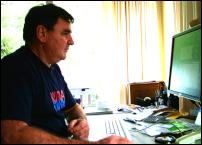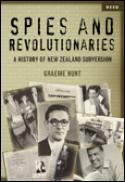Graeme Hunt's Book on New Zealand Spies and Revolutionaries – Chapter Eight: Petrov’s dog
Scoop is serializing the first 1000 words of each chapter of author Graeme Hunt's latest book: Spies And Revolutionaries – A History of New Zealand Subversion. Click here for Chapter Eight: Petrov’s dog
 The history of New Zealand's intelligence agencies and
those it has spied on have been laid bare in a book by
Auckland-based journalist, author, and historian Graeme
Hunt.
The history of New Zealand's intelligence agencies and
those it has spied on have been laid bare in a book by
Auckland-based journalist, author, and historian Graeme
Hunt.
Spies And Revolutionaries – A History of New Zealand Subversion details how several prominent New Zealanders, all of whom are dead, spied for the former Soviet Union during the Cold War. Accusations and suspicions are laid bare before files and information that has never before been made public. This book will clearly recharge debate as to whether Dr Bill Sutch, diplomat Paddy Costello, and public servant Ian Milner were spies acting against New Zealand's national interest.
 On
3 April 1954 Vladimir Petrov, the squat third secretary of
the Soviet embassy in Canberra, climbed into the back of a
car in Sydney belonging to the Australian Security
Intelligence Organisation. He was clutching a satchel
containing embassy documents. The vehicle travelled to a
safe house on Sydney’s North Shore where Petrov exchanged
the contents of the satchel for £5000 cash from an Asio
officer. It was the perfect defection; Petrov had signed a
request for political asylum the previous day and had met
the director-general of Asio, Colonel Charles Spry. But it
would be another 10 days before Prime Minister Robert
Menzies would tell the Parliament that Petrov had defected
and another 14 months before a Royal Commission on Espionage
would report on the extent of the Soviet spy network in
Australia.
On
3 April 1954 Vladimir Petrov, the squat third secretary of
the Soviet embassy in Canberra, climbed into the back of a
car in Sydney belonging to the Australian Security
Intelligence Organisation. He was clutching a satchel
containing embassy documents. The vehicle travelled to a
safe house on Sydney’s North Shore where Petrov exchanged
the contents of the satchel for £5000 cash from an Asio
officer. It was the perfect defection; Petrov had signed a
request for political asylum the previous day and had met
the director-general of Asio, Colonel Charles Spry. But it
would be another 10 days before Prime Minister Robert
Menzies would tell the Parliament that Petrov had defected
and another 14 months before a Royal Commission on Espionage
would report on the extent of the Soviet spy network in
Australia.
While the events of Petrov’s defection, and those of his wife, Evdokia, were unfolding before the world, a 41-year-old New Zealand academic was leading a comfortable life in Czechoslovakia in a way that only a high-ranking communist in a communist country could. His name was Ian Milner, a former Rhodes scholar who, like fellow Kiwi Paddy Costello, was a Soviet spy.
This quiet senior lecturer in
English at Charles University, Prague, paid scant attention
to the Cold War revelations downunder. Apart from spying
routinely on fellow academics for the villainous
Státní bezpečnost (StB), the Czech secret police,
Milner’s immediate concerns were personal rather than
political or ideological; he was caught between two women:
Margot, his arthritic New Zealand-born wife (a pianist and
fellow communist), and his mistress, Jarmila Fruhaufová, a
former Czech diplomat whom he had met at the United Nations
a few years earlier. It was only when his youngest brother,
John, telephoned from London in September 1954 to tell him
he had been named in the royal commission report that Ian
realised his communist world was tumbling around him. Ian
had been listed as one of six suspected spies in the
commission’s mammoth final report released to Parliament
on 14 September 1955. He had, according to the report,
probably passed secrets to Moscow when he was an official in
the Department of External Affairs, Canberra, in
1945–46.
To an outsider, the case against Milner was built on hearsay and flimsy evidence and would not have proceeded in a normal criminal court. It was based on five strands:
• the leaking to Moscow of top-secret British security papers in March 1945 that had been in Milner’s possession –– one covering the Western Mediterranean and Eastern Atlantic and the other, India and the Indian Ocean;
• an army officer’s suspicions of Milner in late 1945 or early 1946 after he had borrowed a top-secret document on international peace-treaty negotiations for 36 hours without explanation;
• Milner’s naming by Petrov in post-defection interviews by Asio officials in April and May 1954 as an ‘important agent’ of the MVD, the Soviet Ministry of Internal Affairs, operating under the codename ‘Bur’;
• confirmation of Milner’s spy status by Mrs Petrov in a post-defection interview with Asio officials in September 1954; and
• unspecified ‘other material’ seen by the commissioners.
Petrov, in reality an alcoholic KGB colonel and head of Soviet intelligence in Australia (though he looked more like a cipher clerk), admitted having no dealings with Milner who, he claimed, had been an active agent before his time and had fled to Prague because he was ‘in trouble’ in Australia. Petrov concluded that Milner had probably been recruited outside Australia. He recalled receiving a cable from Moscow requesting him to make inquiries about Milner’s standing with External Affairs. Milner apparently wanted to go back to New Zealand to ‘live with his parents’.
Mrs Petrov, officially a clerical secretary and accountant at the Soviet embassy in Canberra until her sacking in November 1953, but secretly a cipher clerk for Moscow’s KI (Committee of Information) establishment in Australia, had a different slant on Milner. She said he had passed ‘extremely valuable information’ to an agent named ‘Klod’ –– later identified as a prominent Australian communist, New Zealand-born Wally Clayton –– adding that Milner had left External Affairs after it was discovered that a document had gone missing. She said Moscow’s inquiry about Milner was not about assisting him to return home to live with his parents but to plant him as a ‘Soviet agent in New Zealand’.1
When the Petrovs were confronted with the inconsistencies in their statements, they changed their tune. Petrov denied knowing why Moscow wanted Milner to return to New Zealand and Mrs Petrov, under duress from her husband, cast doubt on whether Bur and Milner were one and the same. She also could not recall mentioning Milner’s association with a missing document from External Affairs. But Asio and the royal commission ignored her revised statement and stuck with the original. It was that earlier statement that forever linked Milner to Klod, though Milner’s name did not appear in a document presented to the commission listing Klod’s contacts –– one of the bundle of Soviet embassy papers Petrov had handed to Asio on 3 April 1954 in return for cash and political asylum.2
The ‘other material’, viewed in secret by the commission and not disclosed until years later, convinced the commissioners that Milner had, on the balance of probability, passed secret documents to the Russians during his brief time at External Affairs. This ‘other material’ we now know comprised decryptions of Soviet signals obtained in the sophisticated Anglo–American Venona codebreaking operation. Milner’s name appeared twice in traffic between the Soviet embassy in Canberra and Moscow’s spy centre. The first, dated 29 September 1945, is part of a report of two meetings that Milner and a junior External Affairs colleague, Jim Hill,3 held with their contact, presumably the spymaster Wally Clayton (Klod). They are reported to have told the contact ‘many interesting things’. The second, dated 6 October 1945, are instructions for Klod and a request from Moscow for ‘detailed biographical descriptions for Milner and Hill’, apparently part of ‘particulars required for clearing’. There was also a reference to Milner and Hill as ‘M. and H.’ (probably before they were assigned codenames). Elsewhere in the Venona decryptions is a report of top-secret British documents being passed to Klod in March 1946, copies of which had been in Milner’s possession at the time.
See Also:
Scoop is serializing the first 1000 words of each chapter of author Graeme Hunt's latest book: Spies And Revolutionaries – A History of New Zealand Subversion.
SRP: $29.99
ISBN:
9780790011400
340p, includes index, black and white
photos
Reed Publishing (NZ) Ltd www.reed.co.nz
Release: August 6 2007
For more, see… Reed Publishers, Spies And
Revolutionaries



 Binoy Kampmark: Warring Against Encryption, Australia Is Coming For Your Communications
Binoy Kampmark: Warring Against Encryption, Australia Is Coming For Your Communications Gordon Campbell: On Fast Track Powers, Media Woes And The Tiktok Ban
Gordon Campbell: On Fast Track Powers, Media Woes And The Tiktok Ban Binoy Kampmark: Censorship Wars, Elon Musk, Safety Commissioners And Violent Content
Binoy Kampmark: Censorship Wars, Elon Musk, Safety Commissioners And Violent Content Gordon Campbell: On The Public Sector Carnage, And Misogyny As Terrorism
Gordon Campbell: On The Public Sector Carnage, And Misogyny As Terrorism Ramzy Baroud: NATO’s Never-ending War: The 75-Year-Old Bully Is Faltering
Ramzy Baroud: NATO’s Never-ending War: The 75-Year-Old Bully Is Faltering Eugene Doyle: Joining AUKUS Not In NZ’s National Interest
Eugene Doyle: Joining AUKUS Not In NZ’s National Interest